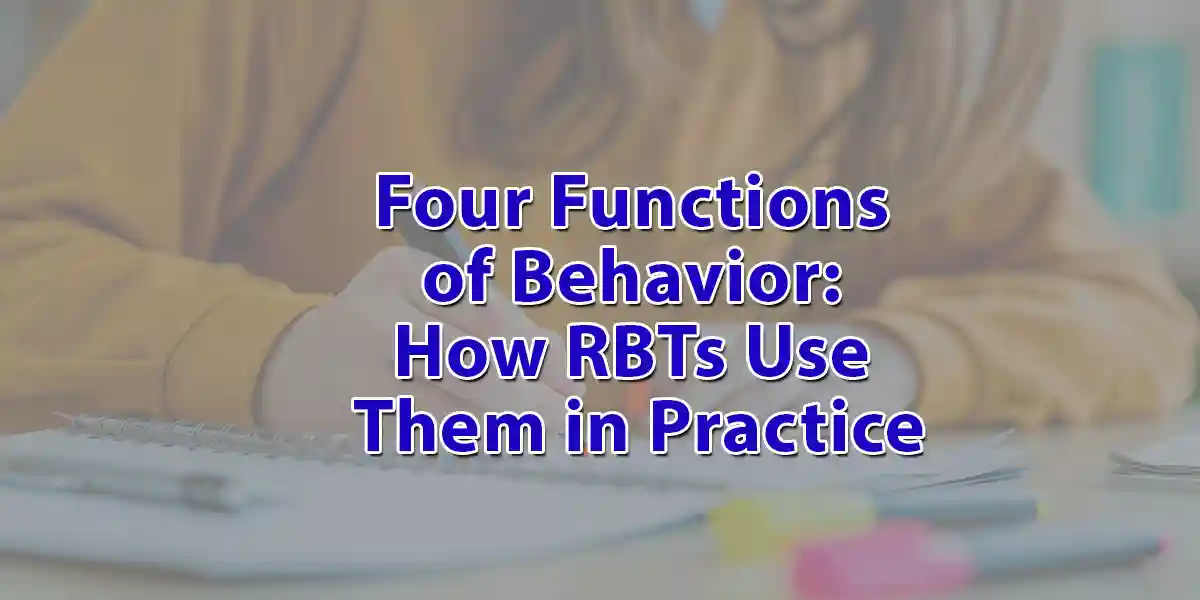Have you ever wondered why someone repeatedly engages in the same behavior, even when it appears illogical? For anyone working with children, teens, or adults in behavior support, this question comes up daily. Registered Behavior Technicians (RBTs) know that every behavior serves a purpose—it’s not random, it’s communication. That’s where the “Four Functions of Behavior” become game-changers.
Understanding these functions isn’t just about theory; it’s about unlocking the “why” behind actions, making it possible to create real, lasting change. By identifying the underlying causes of behaviors, RBTs eliminate uncertainty, lessen frustration, and pave the way for successful interventions. Let’s dive into what these four functions are and how RBTs use them every single day.
What Are the Four Functions of Behavior?
At its core, every behavior—positive, negative, or somewhere in between—happens for a reason. Applied Behavior Analysis (ABA) refers to these reasons as “functions.” The four functions of behavior are
- Attention
- Escape (or Avoidance)
- Access to Tangibles (Items/Activities)
- Sensory/Automatic Reinforcement
Every challenging outburst, every cheerful high-five, and every attempt to get out of a task can be traced back to one (or sometimes more) of these four motivators. Understanding which function is at play helps RBTs match the right intervention, making their work far more effective.
Attention: The Power of Social Connection
Attention-seeking is one of the most common—and misunderstood—functions of behavior. It’s not just about “bad” behavior; everyone needs connection. When a child calls out in class or a client repeats a joke over and over, they may simply want someone to notice, respond, or interact.
Examples of Attention-Maintained Behaviors:
- A student shouts when the teacher turns away, prompting the teacher to respond.
- A child laughs loudly during circle time, and classmates giggle.
- A teenager interrupts others during group activities to gain focus.
How RBTs Respond:
RBTs use observation and data collection to determine whether attention sustains a behavior. If every time a certain behavior occurs someone reacts—scolds, comforts, laughs, or even just looks—that’s a clue.
Practical RBT Strategies:
- Planned Ignoring: Withholding attention for unwanted behaviors while still providing plenty of praise for positive behaviors.
- Differential Reinforcement of Alternative Behavior (DRA): Teaching and reinforcing more appropriate ways to gain attention, like raising a hand or using a communication device.
- Catch Them Being Good: Provide consistent, genuine attention for positive choices, eliminating the need for clients to “act out” in order to gain attention.
Attention is powerful fuel—so RBTs use it wisely, making sure it supports growth rather than reinforcing problem behaviors.
Escape or Avoidance: Getting Away From Unpleasant Situations
Escape-motivated behaviors are all about getting out of something difficult, boring, or unpleasant. Imagine a student who always asks to use the restroom when math starts or a child who melts down when it’s time to clean up toys. These are classic examples of escape.
Examples of Escape/Avoidance Behaviors:
- Leaving the table during chores is a common practice.
- When presented with a challenging worksheet, the child exhibits a tantrum.
- Arguing, shutting down, or refusing to respond during transitions are common behaviors.
How RBTs Respond:
Pinpointing escape as the function means noticing that a behavior happens right before a demand or activity is removed. If the problem stops as soon as the person is excused from the task, escape may be the underlying function.
Practical RBT Strategies:
- Task Modification: Break down tasks, offer choices, or make work more engaging to reduce the urge to escape.
- Non-Contingent Escape: Providing breaks at regular intervals, regardless of behavior, to teach that escape is available in appropriate ways.
- Teaching Coping Skills: Training clients to request breaks politely, signal discomfort, or ask for help instead of acting out.
- Prompting Persistence: Using gentle encouragement and praise when a client stays engaged, even briefly.
The goal isn’t to “force” compliance but to show that there are easier, more effective ways to get needs met.
Access to Tangibles: Getting What You Want
Sometimes, behaviors happen because the individual wants something tangible: a snack, a favorite toy, a turn with a device, or access to a specific activity. When the behavior results in obtaining a desired item, he grabs another child’s toy without asking.
Examples of tangible-maintained behaviors:
- Grabbing another child’s toy instead of asking.
- I’m screaming at the store to get a candy bar.
- Hitting the button on a vending machine repeatedly after being told “no.”
How RBTs Respond:
Careful ABC (antecedent-behavior-consequence) data collection helps RBTs spot patterns. If the behavior almost always results in access to an item or activity, directly or after a meltdown, the function is likely tangible.
Practical RBT Strategies:
- Functional Communication Training (FCT): Teaching clients to request items or activities appropriately (using words, signs, or pictures).
- Delay and Denial Tolerance: This involves gradually teaching clients to wait or calmly accept a “no” response, often by using timers or visual schedules.
- Offering Choices: Empowering clients by giving reasonable choices, which reduces the urge to demand or grab.
- Prompting and Reinforcement: Rewarding polite requests with access to desired items.
By making sure the right behaviors are the “shortcut” to what’s wanted, RBTs can transform struggles into success stories.
Sensory or Automatic Reinforcement: When Behavior Feels Good
The final function is often the trickiest to spot: sensory or automatic reinforcement. This means the behavior itself is rewarding, regardless of what’s going on around the person. Think of a child who rocks back and forth, a teen who hums quietly, or someone who picks at their skin. The sensory experience—movement, sound, pressure, or even pain—provides internal satisfaction.
Examples of Sensory/Automatic Behaviors:
- The woman is flapping her hands, spinning, or rocking.
- You’re twisting your hair or biting your nails.
- They engage in repetitive humming, tapping, or staring at lights.
How RBTs Respond:
If a behavior continues to occur even when no one is observing and there are no apparent changes, it may be due to sensory reinforcement. These behaviors often occur during downtime, stress, or excitement.
Practical RBT Strategies:
- Sensory Alternatives: Offering safe, appropriate ways to meet sensory needs (e.g., fidget toys, movement breaks, noise-canceling headphones).
- Environmental Changes: Adjusting lighting, seating, or noise to minimize discomfort or overstimulation.
- Differential Reinforcement: Encouraging alternative behaviors that are less intrusive or more functional.
- Scheduled Opportunities: Incorporate sensory activities into routines to proactively meet needs.
With sensory functions, the goal isn’t to “eliminate” the behavior but to ensure safety, respect, and access to learning.
How RBTs Identify the Function of Behavior
Recognizing the function isn’t always straightforward. Many behaviors seem to serve multiple purposes or shift from one function to another, depending on the setting or day. Here’s how RBTs address this issue:
- Data Collection: Detailed ABC notes (antecedent, behavior, consequence) reveal patterns over time.
- Interviews involve speaking with teachers, family members, or the client to gain additional insight.
- Direct Observation: Watching the behavior across different environments.
- Functional Analysis: Testing hypotheses by intentionally changing consequences or antecedents and observing results.
Teamwork and careful analysis are key. No two people are alike, and functions can even change as clients grow and learn.
Applying the Four Functions in Real Life: Examples and Solutions
To see these concepts in action, let’s break down some real-life examples:
Example 1: Attention
- Scenario: Jake, age 7, repeatedly calls out during storytime.
- Observation: Each time Jake interrupts, the teacher responds (sometimes by scolding, sometimes by answering).
- Intervention: The RBT coaches the teacher to provide more positive attention when Jake raises his hand and to ignore off-topic comments as much as possible. The teacher teaches Jake to use a “question card” when he wants to speak.
Example 2: Escape
- Scenario: Maya, age 10, leaves her seat every time math homework begins.
- Observation: We give Maya a few minutes to explore before asking her to come back.
- Intervention: The RBT introduces short, frequent breaks, gives Maya choices about the order of assignments, and teaches her to ask for help. Over time, she transitions from leaving her seat to escape to requesting a break or assistance.
Example 3: Tangible
- Scenario: Lucas, age 4, screams in the grocery store until he gets a snack.
- Observation: Lucas receives a snack to calm him down each time he screams.
- Intervention: The RBT works with Lucas’s parents to practice saying “snack, please” before shopping trips. We reward calm, appropriate requests; we no longer give snacks in response to screaming.
Example 4: Sensory
- Scenario: Priya, age 15, taps her pencil constantly during tests.
- Observation: Priyaps to see whether anyone is watching or not.
- Intervention: The RBT offers Priya a quiet fidget tool and a short movement break after the test. The tapping decreases as her sensory needs are better met.
Common Mistakes When Identifying Functions—and How to Avoid Them
Even experienced RBTs can make errors when identifying the function of a behavior. Some classic pitfalls include:
- Assuming “bad” behavior is just for attention: Sometimes escape, tangible, or sensory functions are missed because attention is the most visible.
- Overlooking medical or physical causes: Pain, illness, or discomfort can influence behaviors, so always rule these out first.
- Ignoring context: The same behavior can serve different functions in different situations.
- Failing to take enough data: Rushing to a conclusion without a full data set leads to ineffective interventions.
Patience, objectivity, and teamwork keep the process on track.
Why Understanding Functions Changes Everything
When you know why a behavior happens, you can:
- Teach better alternatives.
- Reduce frustration for everyone involved.
- Build trust and safety.
- Set realistic, achievable goals.
- Support true learning and independence.
For families, educators, and RBTs, seeing behavior as communication shifts the focus from “fixing” to understanding and supporting. That’s where true progress begins.
Using Functions to Build Effective Behavior Plans
Once the function is clear, RBTs can:
- Modify antecedents: Change the environment or triggers to prevent challenging behaviors.
- Teach new skills: Show clients better ways to meet their needs (asking for help, requesting breaks, etc.).
- Reinforce desired behaviors: Make sure positive actions get attention, rewards, or access to preferred items.
- Adjust consequences: Avoid accidentally rewarding challenging behaviors.
Behavior plans based on accurate function assessment are more likely to succeed and less likely to frustrate everyone involved.
Ethical Considerations in Function-Based Interventions
Ethics matter. RBTs must always:
- Respect the dignity and autonomy of every client.
- Avoid punishment as a first-line strategy; focus on teaching and reinforcement.
- Consult supervisors and teams.
- Obtain consent for interventions.
- Protect privacy and data.
By following ethical guidelines, RBTs ensure interventions are safe, respectful, and truly helpful.
Conclusion: Bringing the Four Functions Into Practice
Understanding the four functions of behavior isn’t just a skill for RBTs—it’s a superpower for anyone supporting others. Every action, every outburst, and every quiet success is sending a message about what matters to that person. By tuning in, collecting data, and applying strategies based on function, RBTs unlock progress that’s meaningful and lasting.
So, next time a challenging behavior pops up, ask yourself: Is it for attention, escape, a tangible, or sensory need? The answer is the first step toward real change—and better days for everyone.

